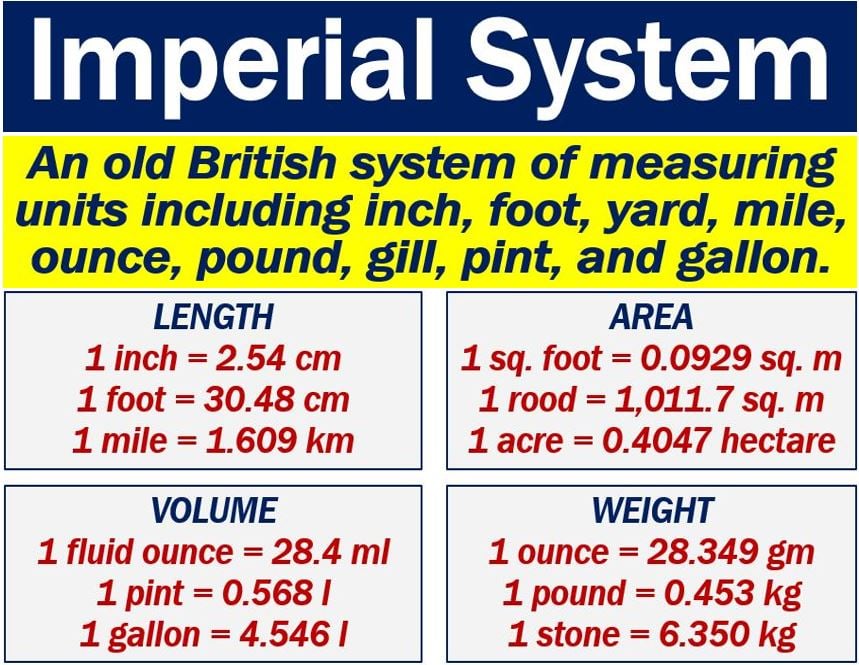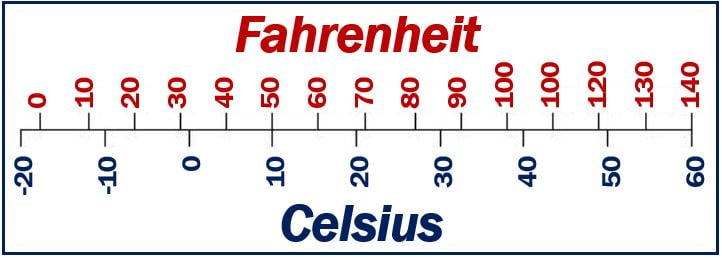Imperial system – definition and meaning
The imperial system is a system of weights and measures that includes pounds, ounces, feet, yards, miles, etc. We also call it imperial units, British imperial, or Exchequer Standards of 1928. The imperial system today contrasts with the metric system, which uses kilograms, grams, centimeters, meters, kilometers, etc.
Imperial units came into force across the British Empire after the British Weights and Measures Act of 1824. They replaced the Winchester Standards, which had existed since 1588.
Over the last century, however, most of the Commonwealth nations have switched from the Imperial units to the metric system. Even the United Kingdom has converted to the metric system for most weights and some other measurements.
Most of the world’s empires had converted to the metric system by the end of the 19th century. The Russian Empire went ‘metric’ in the late 1860s thanks to Dmitri Mendeleev, the ‘father of the Periodic Table.’
The United States has held on to the old units more than the UK. Americans still use pounds and ounces. Britons today, on the other hand, are more familiar with grams and kilograms.
Oxford Learner’s Dictionaries says the following regarding imperial units:
“The imperial system is the traditional system of weights and measures in Britain, which is gradually being replaced by the metric system. Customary measure used in the US is similar to the imperial system with a few slight differences.”
Although the imperial system has mostly gone in countries like the UK and Canada, many older citizens still use it.

Imperial system – measurements
The imperial system, like the metric system, has measurements for area, length, volume, and weight.
Length
Examples of imperial lengths are inches, feet, yards, and miles.
Examples of metric lengths are centimeters, meters, kilometers.
1 inch = 2.54 centimeters., 1 foot = 30.48 centimeters,
1 yard = 0.914 meter, 1 mile = 1.609 kilometers.
Area
Square feet, roods, and acres, for example, are imperial measurements for areas.
Square millimeters, square centimeters, square meters, and hectares, for example, are metric measurements for areas.
1 square foot = 0.0929 square meters, 1 rood = 1,011.7 square meters,
1 acre = 0.4047 hectare.
Volume
Examples of imperial volumes are fluid ounces, gills, pints, quarts, and gallons.
Examples of metric volumes are milliliters and liters.
1 fluid ounce = 28.4 milliliters, 1 gill = 14.2 centiliters, 1 pint = 0.568 liter,
1 gallon = 4.546 liters (1 US gallon = 3.785 liters)
Weight
Drams, ounces, pounds, stones, long hundredweights are examples of imperial weights.
Milligrams, centigrams, decigrams, grams, kilograms, and tons are examples of metric weights.
1 ounce = 28.349 grams, 1 pound = 0.453 kilograms,
1 stone = 6.350 kilograms
Temperature
The imperial unit is Fahrenheit while the metric one is Celsius.

American vs. imperial system
People in the United States use the US Customary Units of measurements. It derives from the English system that people used in the Middle Ages.
As the Imperial system also derives from the English systems of the Middle Ages, the two systems are quite similar. However, there are some differences.
While the American system is based on the early British systems, the Imperial system was defined in 1824. This was after America’s independence. America, therefore, continued with the old system.
Volumes are different
One imperial fluid ounce, for example, equals approximately 0.960 American fluid ounces. One imperial gallon equals 1.2 Americans gallons.
Lengths and distances are the same
Regarding lengths, the American system and imperial system are the same. One American mile, yard, foot, or inch equals one imperial mile, yard, foot, or inch.
Weights – different terms
Regarding weights, although US and British pounds are the same, Britons have historically used the ‘stone.’ One stone equals fourteen pounds. Americans do not use stones.

